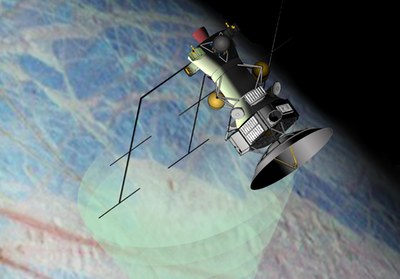Funding the search for life in the solar systemby Lou Friedman
|
| The search for extraterrestrial life is very much a search for ourselves. |
But the possibility of life in the water has dramatically changed our view about the habitability of other worlds. This past year has seen a number of reports about the possibility of life on Titan, as well: in the atmosphere, on the surface, or in its hydrocarbon lakes. Some suggest there could be a methane-based bacteria and chemistry based on the liquid cycle of hydrocarbons rather than water. For those who find life without water too improbable there is Enceladus, another Saturnian moon of astrobiological interest, where salty water has been observed and measured by the Cassini spacecraft.
Even more bizarre there is now a suggestion, in a paper by presented at last month’s American Geophysical Union meeting, that Pluto may have enough internal heat from radioactive decay in rocks to create a liquid ocean under its frozen surface. Where there is water, there might be life. And while there is little suggestion of life on an asteroid, there are observations of amino acids and organics in meteorites, which lend credence to speculation about asteroids carrying the building blocks of life to the planets.
None of these other locales make Mars less interesting. It is still the only world with a known atmosphere and visible evidence of water. It is also the only world we can reach in the foreseeable future to investigate possible extraterrestrial life. It is Mars’s accessibility, in addition to its environmental conditions, that makes the planet so special and why it has been the prime target for exploration over the entire space age (and even before). For those of us who have spent a lot of time discussing space with the public, young and old, the questions about past, present, or future life on Mars dominate all other. That this search now encompasses the whole solar system only makes it more interesting.
The search for extraterrestrial life is very much a search for ourselves. We want to understand our place in the universe, the conditions that make us unique or special, the evolution of how we came to be, and our ultimate destiny—on planet Earth and perhaps other worlds. Just as compelling as the search for past or present life elsewhere is the search for human habitability, especially on Mars. If humans can establish themselves on Mars within this century, then probably life travelling in the universe is common. After all, we will have demonstrated an ability to move between worlds in a relatively short time after first learning to break the bonds of gravity If, despite Mars being so close and relatively friendly, we don’t establish humans on Mars, then it’s my view that probably life doesn’t travel well in the universe.
| Perhaps we can get a $1-billion-per-year increase by sparking positive religious interest in astrobiologic exploration. |
These questions about ourselves and the nature and destiny of life are also questions that religions address. I think that accounts for a good part of the public interest in Mars and in the search for extraterrestrial life. We might benefit from engaging with those religious interests more. I am focusing on the intellectual parts of religious inquiry, that search to understand our place in the universe, and not the assertive parts that seek to spread their “truth,” or the fundamental parts that want no inquiry at all. I have been fortunate to have personal experience with religious leaders deeply interested in space exploration: Father John Minogue, President of DePaul University, was on The Planetary Society Advisory Council, as was Father Ted Hesburgh of Notre Dame. I spent a full day in a very small group with the Dalai Lama, much of it devoted to discussing mutual interest in the scientific search for extraterrestrial life and in other aspects of planetary exploration. I’ve had other equally intense personal experiences with Jewish and Muslim leaders interested in the questions of life on other worlds.
The public’s interest in life in the universe is a fundamental interest for us to tap into and harness, for the missions that seek to understand and find that life are expensive. We seek billions and billions of dollars for astrobiological missions and the search for extraterrestrial life.
Let’s estimate, very roughly, the billions that will be sought in the next few decades: Mars landers = $2 billion; several Mars Sample Return missions = $8 billion; Europa orbiter and lander = $4 billion; Titan lander with some sort of boat and/or balloon = $5 billion; a few missions to small bodies including Enceladus = $3 billion. Let’s try to do all of this by 2040: less than 30 years from now. The missions above total $21 billion, which comes out to approximately $700 million/year. I will round that up to $1 billion per year. That is about five percent of NASA’s current budget, 20 percent of their space science budget, and about 70 percent of their planetary exploration budget. That is a lot, but it isn’t an order of magnitude problem. Perhaps we can get a $1-billion-per-year increase by sparking positive religious interest.
Space interests have sought involvement from charitable interests that promote scientific inquiry and humanity’s accomplishments; they have sought to involve private and commercial interests that wish to develop new products and services for business and profit; and they have sought to involve the industrial community seeking to advance technology and processes for product development. Maybe they should also seek to involve religious communities and philosophers seeking to understand our place in the universe.
